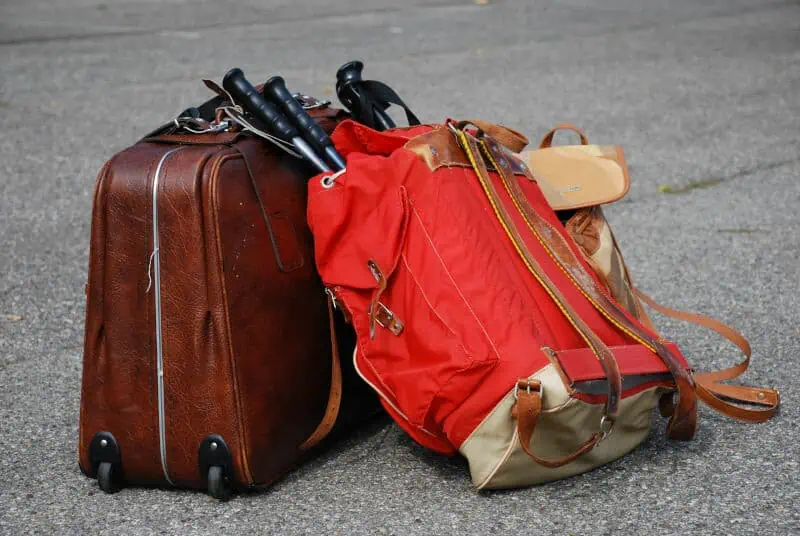Going for a walk while on holiday is a popular activity for all ages and levels of fitness. As anyone who has tried them knows, using walking poles makes this activity much easier. However, when it comes to packing, you might need clarification to determine if you can take your walking poles. Can they go in the cabin with you as carry-on luggage, or must they be checked in the hold?
The answer is complicated and depends on the airline and the pole type. In this article, we’ll discuss whether or not it’s possible to bring your walking poles onto a plane and provide some tips for packing them safely if necessary.

Can You Bring Hiking Poles on a Plane?
When traveling with hiking sticks on a plane, the best advice is to check with the airline ahead of time to determine any specific restrictions. Some airlines may allow poles in the cabin as part of your carry-on baggage allowance, while others require that they be checked in. In addition, some airports enforce stricter regulations at security, and they may refuse to allow you to take your walking poles through. Depending on the airport’s policy, this can cause extra fees or even lead to lost or damaged items. The safest thing to do is pack your hiking sticks in your hold luggage, not your carry-on luggage.
When checking your poles, securely wrap them up and secure them with straps or bungee cords to prevent them from opening during transit. Additionally, it’s essential to label them clearly with your name and contact information before checking them to reduce the chances of them being lost or misplaced. You should also consider taking pictures of your poles before packing them so that you have evidence of their condition prior to being checked in.
When flying with walking poles in the cabin, it’s essential that they fit within any size limits set by the airline and that all sections are collapsed for safety reasons. It can also be helpful to place some padding around the tips and handlebar so they don’t accidentally damage other passengers when walking around the cabin or overhead compartments. Finally, for metal poles, removing any detachable parts such as baskets, wrist straps, or clips is advised to reduce bulk and ensure a more straightforward inspection process at airport security checkpoints. Following these tips will ensure a smooth journey with your walking poles no matter where you’re headed!
International Rules and Regulations That Apply to Taking Walking Poles on Planes?
There is no one rule that applies everywhere. Each country has its own set of rules and restrictions. However, they tend to be similar and aimed at making sure your equipment can’t be used as a weapon and that it has no soil on it that could bring in unwanted bacteria and contaminants. Bear in mind that airlines can have their own rules that differ from the national ones.
What Rules Does the TSA Apply to Bringing Hiking Poles on Planes in USA?
The Transportation Security Administration (TSA) considers your walking poles to be “sports equipment” when traveling by plane in the United States. This means they allow you to bring them on the plane with you, provided they meet specific size and weight requirements. Generally, walking poles should be at most 48 inches and not exceed 25 lbs in weight. You cannot take them as carry-on; they must be in your checked baggage.

Telescopic poles have their own set of regulations that must be followed. Telescopic poles should be collapsed and secured with a locking mechanism before bringing them onto the plane. This is generally done using straps or cords provided by the airline or manufacturer of the poles.
Finally, any electrical devices within your hiking poles (such as shock absorbers) are also subject to airport security screening since they can contain lithium batteries or other hazardous materials. Any items that fail inspection must be removed from your luggage and stored elsewhere during your flight, or they will have to be checked in along with your other baggage items.
By following these guidelines and knowing what rules the TSA applies to hiking poles on planes in America, you can ensure that your trip goes smoothly and you don’t run into any unexpected problems when boarding a flight with your precious cargo!
https://www.tsa.gov/travel/security-screening/whatcanibring/items/hiking-poles
What Does Canada Say About Trekking Poles on a Plane?
Hiking sticks are not permitted through the security checkpoint. The only exception is if the hiking stick is being used as a mobility aid, for example, in place of a cane. A Screening Officer will inspect the stick as part of the screening process. When entering Canada, you must also have your walking poles inspected and disinfected at Customs.
Transport Canada says hiking sticks are allowed on board aircraft in checked baggage if they meet size and weight requirements. Generally, these poles must be less than 107 cm and no more than 23 kg in total weight. However, some airlines may have different restrictions or limits regarding the size and weight of hiking sticks that can be brought on board.
When traveling with hiking poles in your checked luggage, ensure they are securely packed so they don’t damage other items or become damaged during transit. Consider packing them in a bag or wrapping them up in clothing so they are less likely to cause harm to other items inside the suitcase. Additionally, if you plan on bringing your poles through security separately from your bag, make sure they are clearly labeled as walking poles and not something else that may be considered a weapon.
It’s important that you check with the airline before traveling if you plan on bringing your walking poles onboard. Rules can differ significantly between airlines, so it’s best to double-check what is allowed and not allowed before making any assumptions about what can be brought onto a plane. Additionally, airports may have specific regulations for all passengers entering their facility—such as local laws about carrying weapons—so make sure to read up on those rules beforehand, too, just to be safe.
https://www.catsa-acsta.gc.ca/en/what-can-bring/item/hiking-stickpoles
What Does the EU Say About Hiking Poles on a Plane?
The European Union (EU) also has rules in place when it comes to hiking poles on planes. According to the EU, walking poles are considered sports equipment and can be brought onboard in your hand luggage as long as they have no sharp points or edges and cannot be used as a blunt instrument. As most hiking poles have a spike on the end, this means, in reality, you can’t take them in the cabin, and they will have to go in the hold.
When checking your walking poles as baggage, most airlines will allow this without charge so long as they do not exceed the size and weight limits applied by the EU. The same goes for carriers within individual EU countries – although these can vary slightly from one airline to another.
To make sure that all of your equipment is safe and secure during transit, it is best to pack your poles in a protective bag or casing. This will help protect them against any potential damage or moisture during the flight and ensure their safety while being handled by airport personnel. Telescopic poles must also be locked before boarding, and any electrical components must be checked beforehand. Additionally, it’s always a good idea to label your bag clearly so there is no confusion about which items belong to you.
Understanding what the EU says about bringing your walking poles on planes can save you from stress and hassle when traveling abroad with your gear. Just remember to check the size restrictions for each airline before booking a ticket, and pack your items carefully so that nothing gets damaged or lost during transit!
https://transport.ec.europa.eu/transport-modes/air/aviation-security/information-air-travellers_en
Does the UK Have Rules About Taking Trekking Sticks on a Plane?
The United Kingdom (UK) generally follows the same guidelines as the EU regarding taking walking poles on a plane. The Civil Aviation Authority (CAA) has strict rules and regulations for all passengers traveling on flights operating within the UK, including those relating to carrying hiking poles. They cannot be taken into the cabin as hand luggage, but they can go in the hold as checked baggage.
In terms of size restrictions, walking poles should not exceed 20 inches in length when collapsed or 80 cm when fully extended. Telescopic poles should be secured with either a locking mechanism or straps provided by the airline or manufacturer. Any electrical components within your walking poles must also be inspected by airport security and are subject to additional checks if necessary.
It’s important to note that some airlines may have their own restrictions and regulations for bringing walking poles on a plane. These can include specific size limits, additional charges, or even an outright ban on certain types of poles, depending on the type of aircraft you’re flying with. Make sure you check with your airline before traveling to know their policies and whether any extra cost will be involved in checking in your poles if necessary.
Overall, the UK does have rules about taking walking poles on a plane. However, each airline may implement their own additional restrictions, so make sure you check with them before traveling so that you can avoid any potential problems along the way
https://www.gov.uk/hand-luggage-restrictions/sports-equipment
Does Australia Have Laws About Trekking Poles?
Australia has some laws regarding trekking poles that travelers should be aware of before attempting to bring them on a plane. Poles are classified as “prohibited weapons” under the Commonwealth Crimes Act, which means that even if you have a valid reason for carrying them onto the plane (such as for hiking), they still can’t be taken into the cabin.
However, if your trekking poles meet specific requirements, they can be checked in and taken on board. The Australian government has stipulated that all trekking poles must comply with aviation security regulations and be made of non-metallic materials such as plastic or wood, have no sharp edges or points, and be less than 1 meter long. Unfortunately, this rules out the majority of hiking poles.
In addition, trekking poles must be appropriately packaged to pass through airport security. This usually involves wrapping them in bubble wrap or placing them into a hard case or protective sheath so that they don’t cause any damage to other passengers or equipment during transit. You can also purchase special bags designed specifically for carrying walking poles, which offer extra protection as well as making it easier to transport them when traveling.
Ultimately, whether or not you are allowed to take your walking poles on a plane depends on the airline and the type of pole you have. Check with the relevant authorities before packing up your gear so you know what restrictions might apply during your journey.
https://www.abf.gov.au/entering-and-leaving-australia/can-you-bring-it-in/categories/misc
What Are New Zealand’s Rules About Hiking Poles?
New Zealand is a popular destination for hikers and trekkers, and its rules regarding hiking poles are relatively relaxed compared to other countries. Generally, you can bring walking poles on board a plane in New Zealand if they fit within the specified cabin baggage size limits set by the airline. They must also be lightweight and constructed of aluminum or carbon fiber and can fit in the overhead locker.
While most airlines will allow you to bring your poles in the cabin with you, some may require them to be checked into the hold if they are too large or pose a risk of causing injury to other passengers. If this is the case, it’s essential to ensure that your poles are securely packed and labeled so they don’t get lost or damaged during transit.
When traveling through New Zealand airports, you may also be asked to demonstrate how your walking pole works before being allowed onboard. This is usually designed to ensure that the pole isn’t used as a weapon and poses no danger inside the cabin. It’s also a good idea to check with your airline beforehand regarding their specific requirements for transporting walking poles in both carry-on and checked luggage. While many airlines will accept hiking poles without issue, some carriers have stricter policies, which could affect whether you can bring them on board.
https://www.aviation.govt.nz/passenger-information/what-can-i-bring/show/hiking-poles
Does Asia Have Rules About Trekking Sticks on a Plane?
Travelers in Asia have to adhere to the rules and regulations of each specific country or airline when bringing hiking poles on board. This means that you may find some varying restrictions depending on your destination. Generally speaking, most airlines will allow you to bring hiking poles in the cabin if they meet certain requirements.
For example, Singapore Airlines states that travelers can carry one set of hiking poles in the cabin, provided that they are smaller than 200cm and weigh less than 32kg. China Southern Airlines has similar restrictions, allowing one set of collapsible walking sticks in the cabin with a combined length and weight not exceeding 200cm and 20kg, respectively.
It’s important to note that many Asian countries don’t allow trekking poles on trains either, as they are considered a potential risk for other passengers due to their length and weight. In this case, you’ll need to check with the specific railway company for more information about their policies regarding trekking poles on board.
In any case, it’s always best to contact your airline ahead of time to confirm their exact rules and regulations related to bringing walking poles with you while traveling. This way, you can plan your trip accordingly and avoid unnecessary delays or complications at the airport!
https://www.singaporeair.com/en_UK/us/travel-info/baggage/baggage-restrictions/
Singapore
When flying to Singapore, hiking poles are not listed as allowed items in carry-on baggage. It’s advisable to check them in with your luggage. For specific and up-to-date information regarding the carriage of such items, you should contact your airline directly. Additional details on what you can and cannot bring in your carry-on baggage when flying to Singapore can be found on Changi Airport’s website here.
Does South America Have Rules About Hiking Poles on a Plane?
When traveling to South America, hikers may wonder whether they can bring their walking sticks or poles with them on the plane. While it is possible to do so, there are a few restrictions that you should be aware of.
Most airlines in South America will allow hikers to bring walking sticks and poles onto the plane as long as they are under two meters long. If your stick or pole is longer than two meters, it has to be checked in as luggage with either regular checked baggage or oversized items, depending on the airline and the item’s size.
In addition, all hiking sticks and poles must be correctly secured to be allowed on board an aircraft. This means that they must either have rubber tips at each end or some form of protective covering such as bubble wrap, cloth, or foam padding placed around them so that they do not cause any damage to the aircraft cabin.
Hiking sticks and poles should also generally follow any additional guidelines set by the particular airline you’re traveling with – for instance, some may require them to remain upright in an overhead bin or storage area for safety reasons. It’s essential to ensure that you check the exact regulations of your chosen airline before attempting to board your flight with walking sticks or poles.
Overall, most airlines in South America will allow travelers to bring their walking sticks and poles onto a plane if they meet specific criteria – but always make sure that you check with your particular carrier beforehand just to be sure!
What Is the Problem with Having Hiking Poles in Carry-on Luggage?
Unlike hair dryers, nail clippers, curling irons, candles, deodorant aerosol can umbrellas and tweezers, taking hiking poles on a plane can be tricky, and it is important to be aware of the potential problems that could arise if your sticks are not properly packed. One of the main issues is that walking poles are often over the maximum length allowed for carry-on luggage, which means they have to be checked in at the airport. These size restrictions are for practical reasons, as the overhead lockers have a limited size.
In addition, most airlines will require that all poles be securely tied together or packed in a sturdy case so they don’t pose a safety risk during flight operations. This can make it difficult to pack your poles because you’ll need to ensure enough room in your bag. Furthermore, since poles are typically made of metal, they may set off metal detectors at security points and could require additional screening. If they have electronic components, you may have to remove the batteries.
Finally, some airlines may prohibit walking poles from being carried in the cabin because they could be used as weapons. Hiking poles are typically made from metal and are solid and rigid, so they could be used as a club. They also usually have a sharp spike on the end that could be used to injure someone. While unlikely, the possibility that your hiking stick could be used to attack someone is the main reason they are not allowed as carry-on luggage.
What Are the Best Ways to Carry Hiking Poles?
The best way to carry your hiking poles depends on the type of pole you have and how long your journey is. If you are only traveling for a short distance, you may be able to take your trekking sticks with you in the cabin. Most airlines allow passengers to bring one piece of luggage plus a personal item (such as a handbag or laptop bag) onto planes, so you should be able to fit your poles into one of those if necessary.
If your journey is longer, you should check in your walking poles instead. This means they must stay in the hold and won’t be easily accessible during the flight. To ensure they are safe during this time, investing in a good quality case that can protect the poles from bumps and knocks while they’re being transported is essential. Ensure the case is sturdy enough that baggage handlers won’t easily damage it.
If you don’t have a case, you must take the time to wrap your walking poles in a protective layer to ensure they don’t damage the rest of your luggage. The sharp edges and the spike could tear fabric and poke holes in your case. They could also be dirty and spoil your clean clothes.
In addition, many airlines classify hiking poles differently from other sports equipment like ski poles or ice axes. This means that different restrictions may apply depending on which airline you are flying with, so it’s always worth checking with them beforehand to make sure everything will be fine with carrying your walking poles on board.
It’s also worth investing in a pair of adjustable trekking poles if possible – these can be split into two shorter pieces for easy stowage and transport, making them ideal for air travel where space is limited. Additionally, some airlines offer specific luggage allowance for trekking equipment such as walking sticks; again, this varies by airline, so check before you book if this applies.
By following these tips and being aware of any restrictions related to taking walking poles onto planes, you can ensure that your valuable and essential outdoor equipment stays safe during air travel – no matter where life takes you!
Why Are Trekking Poles Helpful?
Trekking poles are an excellent asset for hikers, offering support and stability when traversing different types of terrain. Here are seven reasons why they can be so helpful:
1. Improved Balance & Stability:
Trekking poles help spread out the weight of your body more evenly, reducing pressure on your joints and helping you maintain balance on uneven surfaces. They also provide stability when climbing or descending steep inclines, making navigating rocky paths or slippery slopes easier.
2. Reduce Fatigue:
By taking some of the strain off your legs and feet, trekking poles can reduce fatigue as you hike for long periods. This is especially beneficial for those with mobility issues or who carry heavy backpacks on their hikes.
3. More Control:
Trekking poles give you more control over your speed and direction, allowing you to make minor adjustments easily without having to stop and readjust yourself manually each time you encounter an obstacle.
4. Protection from Injury:
Trekking poles can help prevent falls by providing greater stability and acting as a protective barrier if you slip or trip on the trail. The tips of the hiking sticks could absorb some of the shock that would typically go straight into your body if you fell unassisted, reducing injury risk significantly.
5. Easier Navigation:
Trekking poles can help you ‘feel’ out obstacles like rocks or roots in the trail ahead before stepping onto them, allowing you to plan and adjust your route accordingly while minimizing potential risks along the way.
6. Markers Along The Trail:
If needed, trekking poles can also be used as temporary markers along the route when navigating unfamiliar areas – for example marking points in different directions where two trails meet up so that retracing your steps is easier if needed later on during your hike.
7. Increased Comfort:
Finally, trekking poles are an invaluable tool for helping to reduce strain in painful areas like hips and knees while walking downhill – taking some of the pressure off these points so that they don’t suffer as much impact during long hikes in rough terrain.
What Are the Best Ways to Carry Hiking Poles When Hiking?
When it comes to carrying your hiking poles, there are a few different options that can provide easy and convenient access and protection from the elements. The most popular way is to carry the trekking sticks in your hands, with the tips pointing downwards so they don’t snag on anything. However, if you are carrying a bag or other items while hiking, there may be better solutions.
One option is to attach your poles to the outside of your pack. This requires straps or clips depending on the type of poles you have. If you’re using collapsible poles that fit together in sections, you’ll need a clip or carabiner to attach them securely. Some packs also come with loops specifically designed for attaching walking poles.
If you don’t want to attach them to your pack but still want them close by and easy to access, then consider using a pole holder or tarp-style pole sling. These holders typically attach to the side of your pack and allow for quick removal and reattachment when needed. Poles slings are similar but are made from a lightweight strap material that wraps around both poles at once – these can provide even quicker access than a holder.
Finally, if you need an even more compact option for transporting your walking poles when not in use (for example, on planes), look for specialized bags made for this purpose. These bags are lightweight and highly resistant against wear-and-tear due to their durable material and construction. They often come with shoulder straps, so they can be carried as a backpack.
Using any of these methods will ensure maximum utility from your hiking equipment while keeping it safe during transport and storage!
What to Look for When Buying a Hiking Stick
If you are considering buying a trekking pole, you will find a bewildering array of choices. With so many options available, it can be challenging to know what to choose. Here are seven essential things to look for:
1. Weight:
When purchasing a hiking stick, it’s important to consider the weight of the walking pole. If the pole is too heavy, it can be difficult to carry and lead to fatigue during your hike. Look for lightweight poles that are durable enough to provide stability and support.
2. Grip:
The grip on a hiking stick should be comfortable and secure to ensure a firm hold while walking. Consider materials such as rubber or foam, which absorb sweat and provide extra cushioning for your hands. Additionally, some grips are adjustable, so you can customize them to fit your hand size.
3. Adjustability:
Many hiking sticks come with adjustable shafts, so you can customize their length according to terrain or preference. Choose poles with quick-lock mechanisms and easy-to-use levers for fast and easy adjustments.
4. Shock Absorption:
Look for poles with shock-absorbing technology that dampens impact while walking, reducing the strain on your joints and muscles. Such technology may also improve stability by providing more contact with the ground surface when taking longer strides or crossing uneven terrain.
5. Materials:
Most modern walking sticks are made from high-quality, lightweight aluminum alloys or carbon fiber, which offer strength and durability without weighing you down too much during trekking or hill climbing. Consider what type of material best suits your needs and if it is resistant to corrosion from harsh weather conditions such as rain or snowfall.
6. Accessories:
Some models of hiking sticks come with accessories such as straps or mud baskets that attach easily below the handle for extra convenience on surfaces like snow or mud-covered trails. Consider what features you need before purchasing to get precisely what you want from your walking pole experience.
7. Price:
It’s also important to consider price when shopping for a hiking stick since cheaper options might not possess necessary features such as shock absorption technology or adjustable shafts that could be beneficial in the long run, depending on your activities outdoors. Make sure you’re getting value for money by comparing prices between different manufacturers before making a final decision.
Are Folding or Telescopic Hiking Poles Better Than Rigid?
Folding and telescopic hiking poles are generally better than solid poles, as they provide more flexibility when adjusting their height and length. This is especially useful for tall hikers who need a longer trekking stick, as well as smaller hikers who require a shorter one. Telescoping poles are ideal for those who need to adjust their hiking pole height regularly, such as when climbing steep hills or descending steps.
Collapsible poles are also popular amongst hikers due to their convenience and ease of storage. These types of walking poles feature several sections that can collapse into each other, making them great for packing away when not in use. They tend to be lighter than telescopic or fixed models and offer some degree of adjustability in length but aren’t as sturdy or stable on uneven terrain.
Solid walking poles are the traditional style and generally offer the most support on all kinds of terrain. They don’t offer any adjustable features, so you’ll have to choose the right size for your height before heading out on your hike, but they tend to last longer than collapsible or telescopic models due to their fixed design.
When choosing between folding, telescopic, collapsible, and solid hiking poles, it’s vital to consider the terrain you’ll be traveling across, your budget, and personal preference. Telescoping models are typically more expensive but offer greater adjustability. At the same time, solid poles might be the best choice if you plan on tackling more technical trails where extra stability is beneficial. If weight and size are an issue, collapsible or folding models might be the best bet, although they usually provide less support than fixed or telescopic options.
What Are the Best Trekking Poles to Buy?
Investing in a good pair of hiking poles can make all the difference if you’re a regular hiker.
But with so many different models available, it’s not easy to know which ones are best suited for your needs. Here are our recommendations:
Black Diamond Walking Poles
These are a popular choice among hikers for their versatility and durability. Made of lightweight aluminum, these poles provide stability and support on uneven terrain, while the adjustable wrist straps and shock absorbers help to reduce strain on hands and wrists. The foam handles are comfortable and non-slip, making them ideal for long hikes or treks.
The telescopic design allows you to adjust the length of your poles easily with simple extending or compressing movements, while the cork grips offer cushioning and extra grip when needed. The Black Diamond Walking Poles also come with removable baskets that allow you to customize your poles for different terrains or activities.
Overall, Black Diamond Walking Poles are an excellent choice for hikers looking for reliable walking poles that can stand up to the test of time. They’re lightweight, durable, adjustable, and comfortable for extended use, so you can enjoy your time on the trails without worrying about fatigue or blisters. The removable baskets are a great bonus, too – allowing you to customize your poles as needed – making these poles an even better value!
Leki Trekking Poles
These are some of the best hiking poles on the market today. They are very lightweight yet incredibly strong, offering hikers stability and support in even the toughest terrain. The telescopic design allows for easy adjustment, making them perfect for varying terrain heights and conditions. Their foam handles provide excellent grip and cushioning, while their cork handles offer even more comfort and control. They also come with adjustable wrist straps for added convenience.
Decathlon Walking Poles
These are an excellent option for any hiker looking for sturdy yet lightweight poles. Constructed from a durable aluminum alloy, these telescopic poles are adjustable to fit your height and terrain conditions and feature foam handles with cork grips for extra comfort. In addition, they come with adjustable wrist straps that help reduce strain on the hands and wrists during long hikes.
Decathlon walking poles are lightweight enough to fit in a backpack or suitcase, making them the perfect choice for hikers traveling with their trekking sticks. They’re also affordable compared to other brands and models, so they won’t break the bank if you decide to take them on your next adventure.
The Brasher Walking Pole
These are an excellent option for those looking for a dependable, lightweight, and durable hiking pole. This pole is constructed with a robust aluminum shaft, making it both strong and lightweight at the same time. This hiking stick also features a comfortable foam handle that provides a good grip and cushioning for long hikes, while a shock absorber helps to ease the impact on your wrists. The pole is also adjustable from 25-125 cm, allowing you to customize it for different terrain types and heights. It’s a terrific option for hikers who want one reliable walking pole without breaking the bank.
The Trail Buddy Trekking Poles
These are an excellent choice for hikers, providing stability, support, and comfort. Made from lightweight aluminum, these poles are strong yet still light enough to be comfortably carried on a plane. The height is adjustable, so you can customize it to suit your needs, and the ergonomic foam handles provide cushioning and a secure grip. The poles also feature adjustable wrist straps and shock absorbers, perfect for long hikes on various terrains.
Nordic Walking Sticks
These are a great choice for anyone looking for a reliable, lightweight, and comfortable set of trekking poles. They provide stability and support on uneven terrain and help reduce strain on hands and wrists during extended hikes. The telescopic design allows them to quickly adjust to different lengths – ideal for those of all heights.
The poles are constructed with highly durable aluminum shafts that are strong enough to handle rough terrain yet lightweight enough not to cause fatigue after long periods of use. Shock absorbers also help reduce impact, while foam handles provide comfort and grip, especially in wet conditions. The cork grips offer additional cushioning and more grip when needed.
Overall, Nordic walking sticks are an excellent option for hikers who want a reliable pole that can handle various terrains. They’re lightweight yet strong enough to withstand bumps or drops along the way, comfortable and adjustable for any height, and come with shock absorbers and foam handles for extra support. For those seeking a reliable trekking pole that won’t break the bank, Nordic walking sticks are definitely worth considering.
FAQ’s About Taking Hiking Poles on a Plane
Understanding airline policies regarding size and weight limits, potential additional fees, and security screening procedures is crucial. In some cases, renting hiking poles at the destination can be a convenient and hassle-free alternative. Addressing these FAQs ensures a smoother travel experience for hiking enthusiasts.
Can I bring hiking poles in my carry-on luggage?
Carry-on luggage typically does not allow for hiking poles due to their size and potential use as a weapon. It’s best to check them in with your other luggage.
Are there any size restrictions for hiking poles in checked baggage?
Airlines usually don’t have specific size restrictions for hiking poles in checked luggage, but it’s important to ensure they fit within the overall size and weight limits of your checked baggage.
Do I need a special case for my hiking poles?
While not mandatory, a special case or bag can protect your hiking poles and other items in your luggage from damage.
Are there any fees for checking in hiking poles?
Most airlines treat hiking poles as regular checked luggage, but it’s wise to check if any additional fees apply, especially if you exceed your baggage allowance.
Can I bring collapsible hiking poles in my carry-on?
Collapsible hiking poles may still be considered a security threat and are typically not allowed in carry-on luggage.
What should I do if my hiking poles are damaged during the flight?
If your hiking poles are damaged during transit, report it immediately to the airline’s baggage claim or customer service department for potential compensation.
Can I wrap my hiking poles to protect them?
Yes, wrapping your hiking poles can protect them and other items in your luggage. Consider bubble wrap or a sturdy bag.
Are hiking poles subject to security screening?
Yes, like all items in checked baggage, hiking poles will go through security screening and must comply with all airline and TSA regulations.
What if my hiking poles are considered a weapon by airport security?
If airport security deems your hiking poles as potential weapons, they may not be allowed on the plane. It’s best to check them in or consult with the airline beforehand.
Can I rent hiking poles at my destination instead of bringing my own?
Many outdoor and sporting goods stores offer rentals of hiking poles, which can be a convenient alternative to bringing your own.
Packing Up – Flying With Hiking Poles
It is possible to take your hiking poles on a plane depending on the airline and the type of pole. It’s essential to know how different airlines and countries classify poles so that you understand what restrictions might apply when traveling with them. If necessary, make sure you pack your hiking poles safely in order for them to pass through security without any issues. By following these tips and being mindful of the rules set by each individual airline, you should have no problem bringing along your trusty trekking stick!








